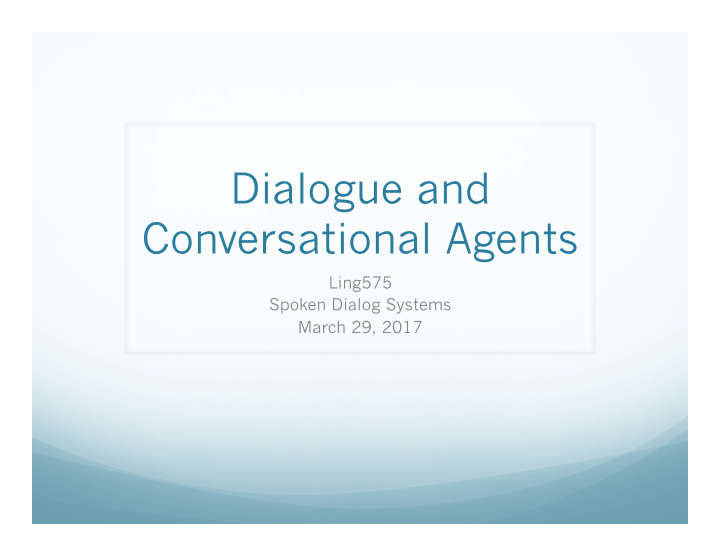



Dialogue and Conversational Agents Ling575 Spoken Dialog Systems March 29, 2017
Roadmap Dialog and Dialog Systems Facets of Conversation: Turn-taking Speech Acts Cooperativity Grounding Spoken Dialogue Systems: Pipeline Architecture Finite-State & Frame-based Models Evaluation
Dialogue is Different
Dialogue is Different Two or more speakers Primary focus on speech
Dialogue is Different Two or more speakers Primary focus on speech Issues in multi-party spoken dialogue
Dialogue is Different Two or more speakers Primary focus on speech Issues in multi-party spoken dialogue Turn-taking – who speaks next, when? Collaboration – clarification, feedback,… Disfluencies Adjacency pairs, dialogue acts
Conversations and Conversational Agents Conversation: First and often most common form of language use Context of language learning and use
Conversations and Conversational Agents Conversation: First and often most common form of language use Context of language learning and use Goal: Describe, characterize spoken interaction Enable automatic recognition, understanding
Conversations and Conversational Agents Conversation: First and often most common form of language use Context of language learning and use Goal: Describe, characterize spoken interaction Enable automatic recognition, understanding Conversational agents: Spoken dialog systems, spoken language systems Interact with users through speech
Why Spoken Dialog Systems?
Why Spoken Dialog Systems? Hands-free operation is needed Speech easier than typing Replace human agents
Why Spoken Dialog Systems? Hands-free operation is needed In-car systems In-field (in space!) assistants Medical systems Immersive training Speech easier than typing Small form factor devices Voice assistants (Siri, Alexa,..) Replace human agents Call centers Call routing
Why is it hard?
Why is it hard? Conversation is complicated Integrates multiple technologies
Commercial Systems: IVR Interactive voice response (IVR) Designed to replace human customer service agents and improve DTMF phone trees: “Press or say ‘one’” Available mid-90s onward Many companies: Nuance, Tellme (MS), Aspect, etc Multi-turn but inflexible interaction Examples: Directory assistance, United Airlines, Verizon, Sears, etc
AT&T’s How May I Help You?
Commercial Systems: Virtual Assistants Leading example: Siri™ Spun out of DARPA project Ties to specific applications Reminders, Backs off to search Lots of “Easter eggs”
Commercial Systems: Virtual Assistants (II) Rapidly growing area: Google Now™ Microsoft’s Cortana™ Some mobile and desktop (Windows/iOS) Amazon’s Echo™/Alexa™ Extensible “skill” sets Plays music, answers questions, interfaces to IoT Far field microphone recognition Google Home™/Assistant™
Dialog Example
Research Systems Aim to push state-of-the-art in component technologies, dialog and interaction strategies Wide range of tasks Training, tutoring, language teaching Planning and negotiation Museum guides, etc Novel components Novel formal models: reinforcement learning, discourse Less-restrictive speech recognition Richer conversational models: turn-taking, back-channels, affect, uncertainty
Travel Planning: Let’s Go! S: Thank you for calling the CMU Let's Go! Bus Information System. This conversation will be recorded for research purposes. If you do not want to be recorded, please hang up now. What can I do for you? U: I would like to go to the airport tomorrow morning. S: To the airport. When do you want to arrive? U: I'd like to arrive at 10:30. S: Arriving at around 10:30 AM. Where do you want to leave from? U: I'd like to leave from Carnegie Mellon. S: From Carnegie Mellon. There is a 28X leaving Forbes Avenue at Morewood at 9:20 AM. It will arrive at Greater Pittsburgh Airport at Departure Stops at 10:15 AM. U: When's the next bus? S: There is a 28X leaving Forbes Avenue at Morewood at 9:40 AM. It will arrive at Greater Pittsburgh Airport at Departure Stops at 10:35 AM. U: I'd like to go from the airport back to CMU on Friday. S: From the airport to CMU. When would you like to leave? U: At 6:15 PM. S: Leaving at around 6:15 PM. There's a 28X leaving Greater Pittsburgh Airport at Departure Stops at 6:26 PM. It will arrive at Forbes Avenue at Morewood at 7:20 PM. U: Thank you very much.
ItSpoke Tutoring System
Commercial vs Research Commercial systems: Emphasize reliability Typically implying more rigid design > 95% accuracy for deployment Research systems: Emphasize flexibility Broader capabilities, flexible language, interaction Goal: research-style flexibility + high reliability
Types of Dialog Systems Command & control In-car entertainment Robotics Information access Q&A, databases Travel, flight booking IVR/ customer service Call-routing, flexible menu structure Flexible assistants Conversational partners, planning, etc
Aspects of Dialog Systems Modalities: Voice only Voice+GUI ECA: robot, talking head Backend system What data/API can it access? What does it know? About the world (domain, open knowledge) About the user (your Google/Amazon info)
Do you use dialog systems? Which ones? Why? What do you like/dislike?
Recommend
More recommend